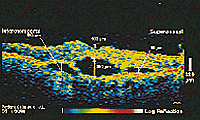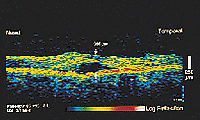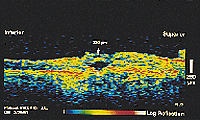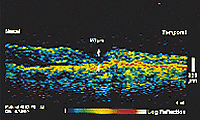TTT may effectively treat CNV, preserving the retina
Infrared energy, which is not absorbed by the clear structure of the eye, slowly raises the temperature to create mild hyperthermia, thereby treating new vessels.
MONZA, Italy — Transpupillary thermotherapy (TTT) is a useful alternative to photodynamic therapy in the treatment of choroidal neovascularization (CNV), and particularly in the ill-defined form, which until now has been considered incurable in most cases.
|
|
|
|
“TTT is the only hope for those eyes, and that’s what makes it so important,” said Elias Reichel, MD, professor of ophthalmology at Tufts University School of Medicine, Boston, who spoke about this treatment at the Vitreoretinal Surgery Congress here.
“Another important aspect is that TTT uses very low laser energy to close the vessels, so that the overlying retina is not damaged and vision is preserved,” he added.
The principles of thermotherapy originate from oncology, where it has been used for many years. Prolonged hyperthermia, up to 44°C, can result in vascular thrombosis.
“The idea is that you can treat CNV using the same technique,” Dr. Reichel said. “By slowly raising the temperature, you can get vascular thrombosis or occlusion in the choroidal neovascular membrane and limit subretinal exudation.”
Slow, gentle treatment
Conventional laser treatment for choroidal new vessels uses very strong laser power and, in this way, the closure of blood vessels may have as a counterpart the destruction of the overlying retina.
TTT uses an infrared (810 nm) Iris Medical OcuLight GLx diode laser (Iridex Corporation, Mountain View, Calif.), which is gentle on the retina.
“We use a low irradiance infrared laser energy instead of high irradiance visible laser energy. The special property of infrared is that it is absorbed deeper, further away from the clear structures of the eye,” Dr. Reichel said.
The delivery system also is different, and consists of a modified, adjustable slit lamp adapter that allows for large spots (up to 3 mm) to be applied to the retina. A large spot allows for efficient dissipation of the heat from the choroid, further reducing the amount of collateral damage to the neurosensory retina.
“When treating ill-defined or occult choroidal neovascular membrane associated with age-related macular degeneration with a 3-mm spot, I apply 800 mW of power for 1 minute. If you reduce the size to two-thirds and use a 2-mm spot, then you should use two-thirds of 800 mW power, which is approximately 550 mW. With a 1.2-mm spot, 40% of the size, the power also should be reduced (40% of 800 mW), which is approximately 300 mW for 1 minute,” Dr. Reichel explained.
|
|
|
|
When treating well-defined or classic CNV, the energy should be further reduced because the lesions are more highly pigmented. The lesser quantity of subretinal and intraretinal fluid also allows a faster temperature elevation.
“In general, for well-defined or classic CNV associated with age-related macular degeneration [AMD], I calculate the power according to the spot size I use, and then reduce it by an additional one-third,” Dr. Reichel explained. “For instance, if I were treating a 2-mm classic CNV lesion with a 2-mm spot size, I would calculate two-thirds of 800, which is 550, and subtract one-third, lowering the energy to approximately 350 mW. For myopia, I reduce the power even further, by one-half of what I would use for occult CNV secondary to AMD. In this case, you may use a very small spot size, say 500 µm, and the power may be approximately 60 or 70 mW for 1 minute.”
Favorable results
Dr. Reichel has treated over 100 eyes with TTT. More than 90% of patients obtained new vessel occlusion and about 75% of patients improved or stabilized their vision.
Currently, he is embarking on a randomized, prospective study involving U.S. centers to prove that TTT is effective in patients with ill-defined CNV.
In the ill-defined form, the choroidal new vessels are often undetectable by fluorescein angiography, and photodynamic therapy is rarely effective.
“The patients I have already treated are largely ill-defined, and most of them were not responding to any other treatment,” Dr. Reichel said. “I am really extremely pleased with the results we are having.”
To illustrate the effectiveness of the treatment, Dr. Reichel showed the preoperative and follow-up Optical Coherence Tomography (OCT; Humphrey Systems, Dublin, Calif.] maps of some of the cases he treated.
“The beauty of OCT is that you can really follow these cases and see the collapse of pigment epithelium detachments and the dispersal of subretinal fluids,” he said.
For Your Information:
- Elias Reichel, MD, can be reached at Tufts University School of Medicine, 750 Washington St., Box 450, Boston, MA 02111-1533; (617) 636-1648; fax: (617) 636-4866; e-mail: Elias.Reichel@es.nemc.org. Dr. Reichel has no direct financial interest in any of the products mentioned in this article, nor is he a paid consultant for any companies mentioned.
- Iridex Corporation can be reached at 1212 Terra Bella Ave., Mountain View, CA 94043; (650) 962-8100; fax: (650) 962-0486; Web site: www.iridex.com.




